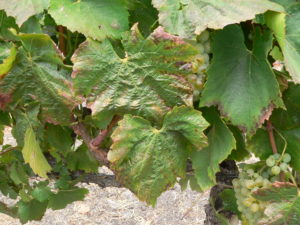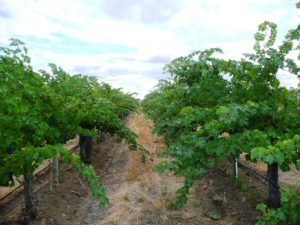Rootstock: The biggest mistake you can make in your vineyard
Selecting the wrong rootstock is something you have to live with
It is not only frustrating, its exasperating, having a new client ask you “what’s wrong with my vineyard” and knowing what the answer is even before delving any deeper about the facts. Sometimes it’s just obvious. The rootstock is not appropriate for the site. Often this is devastating. While we can change scion varieties, amend soils, irrigate and fertilize differently, one thing we cannot change is rootstock. Not in any cost-effective way. Approach or inarch grafting is a way to graft a new root system onto an existing plant, and many attempts were made to do this during the AxR1 failures of the 90’s. Most of those attempts were not successful enough to indicate that rootstocks could be replaced effectively that way. So, for all practical purposes, the one thing you’re stuck with, short of replanting the vineyard, is your rootstock. So make sure its going to work.
Finding the right rootstock is not trivial. If it were, consultants like myself wouldn’t constantly be asked to choose rootstocks for vineyard developments based on factors such as soil characteristics, weather and water patterns, grape variety and quality targets.
Here are some of the most common foibles I’ve seen. The list is not exhaustive by any means.
Soil Chemistry Mismatches
Soil chemistry is so complex that choosing a rootstock that is inappropriate for a specific soil chemistry condition is probably the most common mistake I see in practice. There are many ways to fail in this regard, but probably the most common one I see involves potassium, or more broadly, the balance among the major nutrient cations: potassium, magnesium, and calcium. While all three nutrients are essential for vine health and proper development of the crop, potassium is the one nutrient that can be problematic both when deficient as well as in excess. Potassium is a mobile nutrient in the plant and is involved with many plant functions, but perhaps the most critical role of potassium is in moisture regulation of the plant, specifically the action of opening and closing the leaf stomatal pores. Vines deficient in potassium do poorly in regulating their hydration. Severe deficiencies can cause basal leaf loss, and as the leaves senesce, they release what potassium reserves they have, which can end up in the fruit. Excessive juice potassium, which is commonly caused by excessive plant potassium levels, may also be caused by senescent leaves, which export their potassium to the vine and clusters before they drop off the vine.

Soils may be naturally high or low in potassium, but more importantly, the three main cationic elements (K, Mg, Ca) must be in balance for them to be taken up in proper amounts. With the exception of some volcanic soils that can have excessive amounts of potassium, soils in coastal California regions tend to be low to moderate in potassium. To make matters more difficult, many soils have elevated to excessive Ca or Mg. Central coast soils tend to be high in Ca while high Mg is found in soils up and down the coast. Serpentine-derived soils, common along the coast, are the extreme with Mg dominating the cation exchange sites of the soils. This can limit K uptake.
Choice of rootstock with respect to potassium is critical. Two common rootstocks used in consideration of potassium are 420A and 101-14, both very commonly used in coastal vineyards. 420A is a great rootstock – low vigor with a decent measure of drought tolerance – and it is very good at excluding potassium uptake into the vine. That can be very useful where soils are excessive or slightly so in potassium, and/or deficient in Mg/Ca that could lead to excessive K uptake. For this reason, it is often appreciated by winemakers who don’t want to see high K concentrations in their juice.
However, in low K soils or high Mg soils, very commonly found in our vineyard soils, severe potassium deficiencies can arise when using 420A rootstock. I’ve seen extreme K deficiency symptoms on 420A-planted vineyards, and their correction requires ongoing soil amending as well as fertilization, both foliar-applied and soil-applied. If not corrected, the severe K deficiencies can hamper fruit sugar accumulation and late-season leaf senescence may actually elevate the juice K, which is the opposite of what motivated the rootstock choice from the start.
On the other hand, 101-14 may be a good choice for soils severely deficient in K or in soils with elevated Mg, which would otherwise restrict K uptake. But, using 101-14 in soils with adequate K can cause elevated plant K and, hence, elevated juice K. Furthermore, 101-14 is one of the least drought-tolerant rootstocks in our arsenal of choices and has the frustrating tendency to shut down after experiencing water stress, dropping leaves, and tending to lag in its recovery. It also performs very poorly in heavy soils, especially those with cracking clays.
The rootstock 44-53 has the distinct feature that it excludes Mg uptake and is sometimes chosen for extremely high Mg soils, though I’ve also seen it used for soils that are simply elevated in Mg. For the latter, the rootstock is a poor choice as it can actually create Mg deficiency in all but soils of the highest Mg excessiveness.
Other rootstocks with a high-K tendency include St. George, 110R, SO4, 5BB, 3309 and Fercal, a rootstock suited for soils with high levels of free lime[i]. These should be avoided where soil K is high. On the other hand, rootstocks with a low-K uptake propensity include 1103P and 420A, already mentioned.
Nematodes
As I indicated in a relatively recent article[i], nematodes can be a serious pest of grapevines, yet are often ignored when selecting rootstocks. Now, lacking fumigation as a soil preparation tool (fumigation was never a good practice anyway), we have limited options for controlling nematodes outside of selecting rootstocks that are resistant to them. I would never ever make a rootstock decision without having done some sampling for nematodes first. Existing vineyards being replanted are almost certain to harbor some species of nematodes, but even some virgin (never-in-grape) soils have shown to contain some important levels of nematodes. We don’t usually see root knot nematode in virgin ground, but we do see dagger (Xiphinema americanum, not X. index) and sometimes ring nematode. So, don’t just assume you can do whatever you want for newly-planted vineyards. Sample for nematodes and let that knowledge be part of the decision process.
Rootstocks vary in their resistance or tolerance to nematodes and in their resistance to specific nematode species. Rootstocks resistant to dagger nematode include O39-16 (which is also resistant to the fanleaf virus vectored by X. index) and Schwarzmann, the latter of which is one of my go-to rootstocks in many situations. Rootstocks resistant to root knot nematodes include 1616C (another favorite of mine), 5C, SO4 and 5BB. Note that I didn’t mention the high-vigor rootstocks tailored for the central valley, namely Harmony and Freedom, though those are acceptable choices for high-production vineyards, usually in the Central Valley
When I see high levels of both root knot and dagger, I often gravitate to Schwarzmann. If X. index is present along with Fanleaf virus in the vineyard, we’re mainly left with O39-16, which is not a great rootstock viticulturally, largely due to its high vigor, and is quite susceptible to root knot nematode. The GRN-series of nematode-resistant rootstocks recently developed by Andy Walker at UC Davis are resistant to a broad spectrum of nematodes, including ring nematode, so heavily infested soils will probably be best served using one of those. GRN-1 seems to be the most promising for coastal vineyards, due to its nematode resistance/tolerance and its moderate vigor.
By the way, notably poor rootstock choices for nematode resistance include 3309C, St. George and 110R. Additionally, 420A and 1103P have low resistance to dagger nematode while having some resistance to root knot.
Waterlogging

When evaluating soils, we look for signs of seasonal waterlogging. This can either be in the form of gleying, a grey-ish coloring often accompanied by a foul, reduced odor, or in the form of rust mottling. We look at the depth or shallowness of the mottles to indicate the depth at which the soil is periodically waterlogged and anoxic. While some of this can be mitigated by drainage, rootstock selection is paramount for surmounting the consequences of waterlogged soils. I’ve seen many sections of vineyards killed by waterlogging and they have almost always been on rootstocks sensitive to that condition.
For waterlogged soils, my go-to choice is 1616C, which is very resistant to that condition. SO4 is also a good choice for excessively wet soil conditions with 101-14 also being a decent choice if waterlogging is not severe or long-term.
Drought Tolerance
This is often the first thing people think of when picking a rootstock. While it can be an extremely important consideration where both water resources and soil water holding capacity are limiting, using the most drought-tolerant rootstock need not always be the primary consideration. For situations where irrigation water is limiting however, one does need to consider drought tolerance. Drought-tolerant rootstocks such as 140Ru, 110R and 1103P are quite vigorous and can exacerbate the water deficiency by rapidly forming a full vegetative canopy and then wasting water by way of their propensity to keep vines unstressed – stomata wide open, even when soil moisture reserves are running low.
Keep in mind that, for fine wine production, we want to induce some water stress in the vines and such drought-tolerant rootstocks may never reach the stress targets we aim for at the phenological stage we desire (i.e. lag phase through veraison).
Caution should be taken against choosing the most drought tolerant rootstocks except where irrigation is limited or soils are extremely limited in their water holding capacity. In the latter case, we can still control vine stress even with drought-tolerant rootstocks because the soils simply won’t hold very much moisture and irrigation can be applied judiciously to steer the vines into a moderate water stress when needed.
For most applications in coastal vineyards, at least those with ample winter rainfall or ample irrigation resources, we usually aim for moderately drought-tolerant rootstocks like Schwarzmann or 3309C (the latter not for nematode-infested soils, though). Or moderate to less-than-moderately drought-tolerant rootstocks like 420A, 5BB (which tends to be vigorous) or SO4. Drought sensitive rootstocks like 101-14 and 1616C need to be used in situations where soils remain moist for an extended period of time and where irrigation is available to carry the vines through the latter part of the dry growing season.
Vigor

This is a slightly complicated factor, since there are more factors that influence vine vigor than rootstock alone. In fact, vine spacing can have a larger influence on the vegetative growth of the vine than rootstock. Planting vines closer together means that fewer buds will be retained per vine, which tends to invigorate shoot growth arising from those buds. So, using a vigorous rootstock can be detrimental in cases where vine spacings are close, such has been the trend in recent years. For example, 1103P rootstock with a 4-foot in-row vine spacing is probably asking for trouble.
With modern vine spacings in coastal vineyards (which tend to be on the order of 4 to 5 feet), low to moderate vigor rootstocks are usually desirable. Choices like Schwarzmann, 3309C (again, only without nematodes being present), and SO4 are good choices in the moderate or moderately-low vigor range. For tighter vine spacings on the order of 3 to 4 feet, low-vigor rootstocks like 101-14, 420A and 1616C are usually better choices. The high-vigor rootstocks like 110R and 1103P perform best for vine spacings of 5-6 feet, though spacings of greater than 5 feet are becoming rare because of a trend towards smaller vines as well as an increasing interest in cane-pruning of vines.
If it were easy, growers would not require the use of experienced viticulturists to choose rootstocks. The fact is, it’s not easy. Taking in all the factors to make a rootstock decision is not trivial or cheap. But making the wrong rootstock decision is even more costly. And long-lasting.
By Mark Greenspan
An edited version of this article appeared in Wine Business Monthly, November 2020
[1] Pouget, R. Methode de classification des varietes de porte-greffes de la vigne en fonction de leurs capacites d’absorption du potassium, du calcium et du magnesium: utilisation comme test de selection pour la resistance a la carence en magnesium. 3. Symposium International, Jun 1986, Bordeaux, France.
[1] Greenspan, M. Replanting Vineyards: Watch Out for Nematodes. Wine Business Monthly. April 2019.



Mark, I can’t agree more. THis is a good article summarizing the rootstock choices.
THank you.
Chris Lindelof
Grey Creek